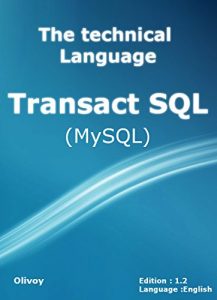The most concentrated guide to learn the language Transact SQL faster
Are You Ready To Learn SQL?
Welcome and have fun with SQL!
Do not forget to leave me a comment ;) Thanks.
Note:
This course is tested under the Database Management System (DBMS) MySQL.
Here Table of Contents
1.Introduction
2.Instruction Categories
2.1.Data Definition Language (DDL)
2.2.Data manipulation language (DML)
3.Sample Database
3.1.MCD
3.2.MLD
4.Creating the database (Command Management)
5.Data Definition Language (DDL)
5.1.Create a table with Data integrity
5.1.1.Creation
5.1.2.Data types
5.1.3.Data integrity
5.1.4.Example
5.1.5.Method 1
5.1.6.Method 2
5.2.Modify a table
5.2.1.Add Column
5.2.2.Edit a column
1.1.1.Remove Column
1.1.2.Delete a table
2.Data manipulation language (DML)
2.1.Data insertion: INSERT INTO
2.2.Changing Data
2.3.Deleting Data
2.4.Selecting data
2.4.1.The operators DISTINCT and ALL
2.4.2.The operator star (*)
2.4.3.The operator AS
2.4.4.The basic mathematical operations
2.4.5.The concatenation operator
2.5.The WHERE clause
2.5.1.Comparison operators
2.5.2.Logical connectors (OR, AND)
2.5.3.Operator IN
2.5.4.BETWEEN operator
2.5.5.operator LIKE
2.6.The ORDER BY clause
2.7.GROUP BY, HAVING and aggregate functions
2.7.1.Aggregate functions
2.8.Set operators : UNION, INTERSECT and EXCEPT
2.8.1.The operator Union
2.8.2.The INTERSECT
2.8.3.The EXCEPT
2.9.join
2.10.Subquery
3.Data Definition Language (DDL)
3.1.Views
3.1.1.Description
3.1.2.Creation syntax
3.1.3.Syntax delete
see also
25 Corrected exercises in Transact SQL
https://www.amazon.com/dp/B01LLVAVY6
Are You Ready To Learn SQL?
Welcome and have fun with SQL!
Do not forget to leave me a comment ;) Thanks.
Note:
This course is tested under the Database Management System (DBMS) MySQL.
Here Table of Contents
1.Introduction
2.Instruction Categories
2.1.Data Definition Language (DDL)
2.2.Data manipulation language (DML)
3.Sample Database
3.1.MCD
3.2.MLD
4.Creating the database (Command Management)
5.Data Definition Language (DDL)
5.1.Create a table with Data integrity
5.1.1.Creation
5.1.2.Data types
5.1.3.Data integrity
5.1.4.Example
5.1.5.Method 1
5.1.6.Method 2
5.2.Modify a table
5.2.1.Add Column
5.2.2.Edit a column
1.1.1.Remove Column
1.1.2.Delete a table
2.Data manipulation language (DML)
2.1.Data insertion: INSERT INTO
2.2.Changing Data
2.3.Deleting Data
2.4.Selecting data
2.4.1.The operators DISTINCT and ALL
2.4.2.The operator star (*)
2.4.3.The operator AS
2.4.4.The basic mathematical operations
2.4.5.The concatenation operator
2.5.The WHERE clause
2.5.1.Comparison operators
2.5.2.Logical connectors (OR, AND)
2.5.3.Operator IN
2.5.4.BETWEEN operator
2.5.5.operator LIKE
2.6.The ORDER BY clause
2.7.GROUP BY, HAVING and aggregate functions
2.7.1.Aggregate functions
2.8.Set operators : UNION, INTERSECT and EXCEPT
2.8.1.The operator Union
2.8.2.The INTERSECT
2.8.3.The EXCEPT
2.9.join
2.10.Subquery
3.Data Definition Language (DDL)
3.1.Views
3.1.1.Description
3.1.2.Creation syntax
3.1.3.Syntax delete
see also
25 Corrected exercises in Transact SQL
https://www.amazon.com/dp/B01LLVAVY6






